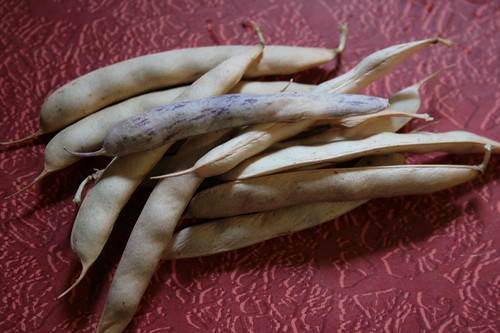Successes
As mentioned in my spring 2009 review, I had good luck with fast-growing spring greens and lettuce. The kale held up through mid-summer, and I was able to plant more kale, bok choy, and raab for a second late fall harvest. I will likely continue with this plan for next year, planting as soon as we build and set out the coldframe in February or March.

But the biggest success in 2009 was the almost continuous harvest of raspberries from August through October. Back in 2008, I planted 5 "Caroline" raspberry bushes in the south garden and backyard. Two of the plants ended up dying that year, but the rest held through the winter and produced their first scant harvests in the spring of 2009. Not expecting much in the way of a second summer/fall harvest, I was surprised when I found the plants abundant with flower and eventually fat red berries. For a few weeks, I was throwing berries on my cereal and yogurt every morning at breakfast. I made several small batches of jam, a few jars of which were given as Christmas presents. After a disappointing season in the vegetable garden, it sure is satisfying to enjoy homemade raspberry jam on your toast.

Another small success came with the “Black Turtle” shelling beans. While the total harvest after shelling turned out the be less than I thought (enough for one meal), I was impressed at the speed with which the plants produced fat pods of black beans in the summer heat. Like most shelling beans, I was able to use them as snap beans when they were young, but most I allowed to dry for later harvest.
The only variety of tomato that produced a steady crop in 2009 was the “Enchantment” saladette. Nice little tomatoes, decent flavor, but definitely not something I’m itching to plant again as my main crop hybrid.
Additionally, I had good success with most the annual herbs I planted, especially the parsley and the dill. The cilantro performed well until mid-summer, after which it died back, a typical habit in this region.
Semi-Successes
While I didn’t get as good a harvest of potatoes as last year, it was solid enough for a meal or too, and I can certainly recommend giving the purple-skinned "Caribé" variety a try if waxy potatoes are your thing. I had decent harvests of the “Jade” and “Gold Crop” bush beans, though it was really only enough to augment what we got from our CSA. The “Dakota” shelling peas and “Sugar Sprint” snap peas also garnered mild yields, but I had hoped for better performance overall. I got a few “Cherokee Purple” and “Striped German” tomatoes, a scant harvest at best. And I harvested a few tiny heads of the Nutri-Bud broccoli.
Failures
I failed to get a harvest from the following:
Fava Bean, "Broad Windsor"
Buttercup Squash, "Discus Bush"
Romanesco Broccoli, "Shannon"
Broccoli, "Waltham 29"
Cabbage, "Early Jersey Wakefield"
Cabbage, "Danish Ballhead"
Cauliflower, "Early Snowball"
Summer Squash, "Ronde De Nice"
Tomatoes, "Black Krim"
Thr brassicaes held up well through the spring and summer, but around the time they started developing heads suffered critter attacks from which they were unable to recover. I do think that if they had been planted in a sunnier locale and able to develop larger heads faster, they might have stood a chance. But alas, it was not to be.
For reasons I don’t fully understand, the fava bean plants only produced one pod before wilting in the summer heat. And the summer and winter squashes were doing quite well until succumbing to stormy conditions.
Lessons for Next Year
The main lesson I’ve learned over these few years of vegetable gardening is to pay close attention to weather conditions, to light and shade and wet. As I pointed out in my previous entry, I misjudged the conditions of the space I chose, which has led to struggles with certain pests, fungi, and overall plant sizes and yields. Luckily, I had a back-up plan in case the space did not work and am going forward with implementation. Rather than being irritated at having to move everything, I’m pretty upbeat about the project and hoping for greater success this coming season.
Another thing I learned in 2009 was the benefit of extending the season with early spring and late fall. With a makeshift coldframe (a glass window over one of the smaller beds, I was able to set out lettuce and spring greens in March when the frost had not quite subsided. And I was able to harvest raspberries, kale, raab, and bok choy through October and into November.
I’ve already started planning for this year’s garden and have bought another batch of seeds, which I’ll be discussing in my next entry.
What were your best and worst gardening experiences of 2009? What did you learn?
No comments:
Post a Comment